#class: trematoda
Explore tagged Tumblr posts
Text
Round 2.5 Final Stats:
The top classes of Round 2.5 have been ranked thusly, listed here from highest ranking to lowest:
Scyphozoa ~ 656
Eutardigrada ~ 656
Hydrozoa ~ 474
Tentaculata ~ 416
Hexacorallia ~ 399
Cubozoa ~ 367
Heterotardigrada ~ 365
“Turbellaria” ~ 282
Octocorallia ~ 279
Staurozoa ~ 245
Nuda ~ 226
Ceriantharia ~ 209
Polypodiozoa ~ 142
Trematoda ~ 73
Catenulida ~ 71
Cestoda ~ 56
Malacosporea ~ 55
Myxosporea ~ 47
Monogenea ~ 35
Unfortunately, none of the classes were able to beat Actinistia and score at least 853 points. So, as promised, only the top-most rated class will be redeemed and move on to Round 3, which in this case is a tie between Scyphozoa and Eutardigrada! Let’s welcome them back into the running and wish them luck in Round 3. Judging by how this round went… they’re going to need it. 🙃
Round 3 will begin February 1st and will feature the Orders of Chondrichthyes, Mammalia, Reptilia, Cephalopoda, Lissamphibia, Actinopterygii, Malacostraca, Arachnida, Insecta, Actinistia, Scyphozoa, and Eutardigrada.
Pack some water, snacks, and road trip games. It’s going to be a long ride!
Extra Stats below the cut:
Cnidarian Class Octocorallia (polyps with 8-fold symmetry)
~ was the first group of the redemption round
~ had the highest percentage of likes at 48.4%
~ had 0 dislikes
Cnidarian Class Hexacorallia (polyps with 6-fold symmetry)
~ had the highest amount of likes at 80
~ had 0 dislikes and 0 hates
Cnidarian Class Cubozoa (“Box Jellyfish”)
~ had 0 hates
Cnidarian Class Hydrozoa (Hydrozoans)
~ had the highest percentage of favorites at 25.3%, along with Scyphozoa
~ had 0 hates
~ had the third most reblogs at 33
Cnidarian Class Scyphozoa (“True Jellyfish”)
~ had the highest amount of favorites at 59
~ had the highest percentage of favorites at 25.3%, along with Hydrozoa
~ had 0 hates
~ had the most notes at 99
~ had the most reblogs at 48
Cnidarian Class Myxosporea (microscopic parasites)
~ had the lowest amount of loves at 5, along with Monogenea
~ had the lowest percentage of loves at 4%
Cnidarian Class Malacosporea (microscopic parasites)
~ had the lowest amount of likes at 16
~ had the lowest percentage of likes at 13.2%
~ had the highest amount of neutral votes at 78
Platyhelminthian Class Catenulida (simple, free-living flatworms)
~ had the lowest amount of favorites at 3, along with Monogenea
~ had the lowest percentage of favorites at 2.7%
~ had 0 hates
Platyhelminthian Class Cestoda (“ Tapeworms” and Cestodarians)
~ had the highest amount of dislikes at 32
~ had the highest percentage of dislikes at 23.7%
~ had the highest amount of hates at 8
~ had the highest percentage of hates at 5.9%
Platyhelminthian Class Monogenea (ectoparasites)
~ had the least votes at 95
~ had the lowest amount of favorites at 3, along with Catenulida
~ had the lowest amount of loves at 5, along with Myxosporea
~ had the highest percentage of neutral votes at 65.3%
~ had the least notes at 13
~ had the least reblogs at 6
Tardigradan Class Eutardigrada (“Smooth-bodied Tardigrades”)
~ had the most votes at 240
~ had the highest amount of loves at 130
~ had the highest percentage of loves at 54.2%
~ had the lowest amount of neutral votes at 8
~ had the lowest percentage of neutral votes at 3.3%
~ had the second most reblogs at 38
Tardigradan Class Heterotardigrada (“Rough-bodied Tardigrades”)
~ had the same amount of loves as likes
~ had 0 hates
Ctenophoran Class Tentaculata (“Tentaculate Comb Jellies”)
~ had 69 loves (nice)
~ had 0 dislikes and 0 hates
Ctenophoran Class Nuda (“Beroids”)
~ had 0 dislikes and 0 hates
#thanks for voting!#unfortunately this round suffered from poor voter turnout I think just due to lack of interest in the animals presented#these guys all did get over 1000 points in round 1 but who knows where all those people are now#I hope this doesn’t seem too unfair to gastropoda because yes it did get more points than these two HOWEVER#I made a promise and I really don’t want this whole round to have been for naught#judging by how this round went I don’t think they’ll make it very far anyway :/#but it’s nice to have a little extra variety and they don’t have quite as many orders THUS not as much extra work for me heh#Anyway I still hope y’all enjoyed and I hope people will be more invested in Round 3 with all the favorites coming back!#poll results#statistics#extras
20 notes
·
View notes
Photo

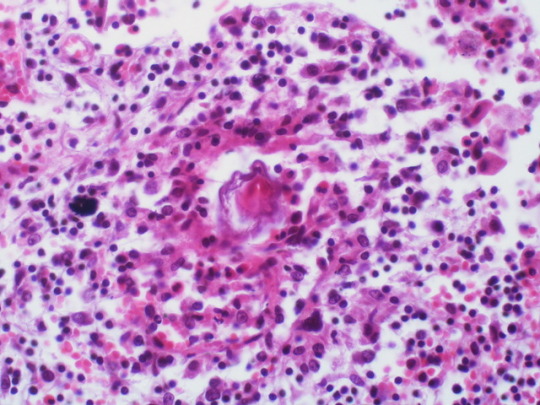
Scientific name: Schistosoma japonicum
Common name: Blood fluke
Local name: Unknown; “Bulate” for worms collectively
Medical importance: Causes schistosomiasis
Schistosomiasis, one of the many neglected tropical diseases, is endemic in the Philippines. 10 of 16 regions in the country have reported cases of clinical schistosomiasis, with 6.7 million people living in the endemic areas [1].
Infection occurs when the person comes into contact with contaminated freshwater, in which Oncomelania snails, a host for the worms, reside. The parasites that multiplied inside the snail leave the intermediate host, enter the water and penetrate a person’s skin. For several weeks, the larvae develop inside the human host and become adult worms. Some mate and produce eggs. Schistosomisis symptoms occur because of the body’s reaction to the eggs being deposited in the intestine or bladder.
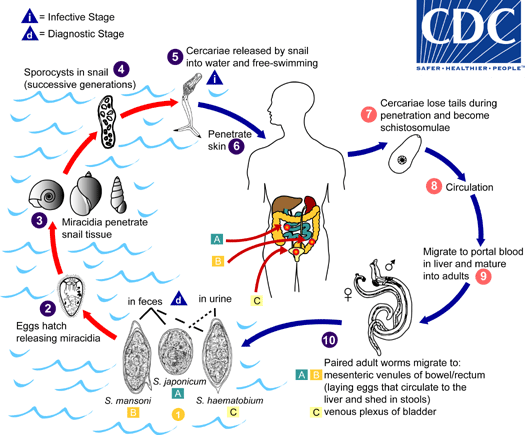
Habitat & geographical distribution: China, Philippines, Indonesia, Japan
Animal description:
Eggs: 5-85µm by 40-60 µm; large, round and non-operculate; transparent shell with a rudimentary lateral spine or knob
Miracidium: Ovoid, ciliated
Cercariae: Elongated; with tapering head and forked tail
Adult: yellow or yellow brown; male - 12mm by 0.5mm, female - 20mm by 0.4mm; strong sucker around the mouth; tegument coated with tiny spines
Treatment: Praziquantel
References:
[1] Gordon, C. A., Acosta, L. P., Gray, D. J., Olveda, R. M., Jarilla, B., Gobert, G. N., … McManus, D. P. (2012). High Prevalence of Schistosoma japonicumInfection in Carabao from Samar Province, the Philippines: Implications for Transmission and Control. PLoS Neglected Tropical Diseases, 6(9), e1778. doi:10.1371/journal.pntd.0001778
[2] Center for Disease Control & Prevention. Schistosomiasis. https://www.cdc.gov/parasites/schistosomiasis/
#Schistosoma japonicum#Schistosoma#disease: schistosomiasis#kingdom: animalia#class: trematoda#common name: blood fluke#parasite#parasitic worms
1 note
·
View note
Text
Platelmintos
são animais que vivem em diferentes ambientes, ocorrendo em ambiente aquático ou terrestre. Além disso, temos algumas espécies parasitas, como é o caso das tênias, chamadas popularmente de solitárias.
Platelmintos são conhecidos como vermes de corpo achatado, devido a sua estrutura corporal ser achatada dorsoventralmente. São animais triblásticos, acelomados e com simetria bilateral. O sistema digestório é incompleto e ausente em algumas espécies. A excreção ocorre por protonefrídio, as trocas gasosas ocorrem por difusão, e o sistema nervoso é provido de gânglios.
Características gerais dos platelmintos O termo platelminto significa verme achatado, sendo essa uma referência ao corpo delgado desses animais, que se apresentam achatados dorsoventralmente. Seu corpo é formado por três folhetos germinativos (ectoderme, mesoderme e endoderme), portanto, são considerados triblásticos. São animais acelomados (não possuem celoma) e apresentam simetria bilateral.
Os platelmintos são animais que possuem um corpo relativamente simples, com muitos sistemas ausentes e outros muito pouco especializados. As trocas gasosas desses animais, por exemplo, ocorrem por difusão pela superfície do corpo. No que diz respeito à excreção, observa-se um sistema simples constituído por protonefrídios, os quais são uma rede de túbulos com estruturas ciliadas conhecidas por células-flama.
Alguns platelmintos apresentam sistema digestório, que é ausente em outras espécies. O sistema digestório dos platelmintos é incompleto, sendo a boca a única abertura para o trato digestivo. Não apresentam sistema circulatório, tampouco sistema esquelético. O sistema nervoso é geralmente constituído por um par de gânglios anteriores que estão associados a cordões longitudinais.
No que diz respeito à reprodução, é possível observá-la de forma assexuada e também sexuada. Muitas espécies são hermafroditas, mas também há espécies de sexos separados. Algumas espécies apresentam desenvolvimento direto, sem uma fase larval, outras, no entanto, apresentam desenvolvimento indireto, incluindo-se um ou mais estados de larva.
Classificação dos platelmintos Existem diferentes espécies de platelmintos, sendo algumas de vida livre e outras parasitas. Dentre estas, podemos citar as tênias e o esquistossomo, enquanto de vida livre, podemos citar a planária. Podemos identificar quatro classes nesse filo: Turbellaria, Trematoda, Cestoda e Monogenea.
Na Turbellaria temos organismos apenas de vida livre, incluindo-se nesse grupo as planárias. Já as classes Trematoda, Cestoda e Monogenea apresentam apenas representantes parasitas. Na classe Trematoda temos como representante o esquistossomo; na classe Cestoda temos as tênias; e na Monogenea, algumas espécies ectoparasitas de peixes, anfíbios e répteis.
Os platelmintos de vida livre são as espécies que não apresentam hábito parasita, sendo encontrados em ambientes de água doce ou salgada bem como terrestres e úmidos. As espécies de platelminto de vida livre mais conhecidas são chamadas popularmente de planárias. Esses animais vivem em ambiente de água doce e alimentam-se de pequenos animais ou animais mortos.
A planária apresenta uma cabeça com um par de ocelos — estruturas que garantem a percepção de luz. Na cabeça observa-se ainda abas laterais que atuam na detecção de substâncias químicas presentes na água. O sistema nervoso desses animais é do tipo ganglionar, apresentando um par de gânglios próximos aos ocelos, de onde partem cordões nervosos ventrais, que percorrem todo o comprimento do corpo.
Esse animal apresenta um tubo digestório que inclui uma boca, porém não apresenta ânus, sendo, portanto, um sistema digestório incompleto. A boca está associada a uma faringe muscular, a qual pode protrair-se (mover-se para frente) a partir da boca durante a alimentação. Sucos digestórios são lançados na presa, e depois a faringe suga o alimento para o interior da cavidade gastrointestinal, onde a digestão será continuada. Inicialmente a digestão é extracelular, porém é completada no interior de células que revestem a cavidade gastrovascular.
A reprodução das planárias pode ocorrer por meio da fissão. Nesse caso, o animal sofre constrição do seu corpo, separando a cabeça da cauda, dando origem a dois indivíduos. Esses animais também apresentam incrível capacidade de regeneração. Se uma pessoa cortar a planária em vários pedaços, por exemplo, estes se regeneram e dão origem a novas planárias.
A reprodução sexuada é também observada nas planárias. Esses animais são hermafroditas, ou seja, em um único indivíduo observa-se a produção de gametas masculinos e femininos. A fertilização nesse grupo é cruzada, pois, na hora da cópula, os parceiros são fertilizados.
Platelmintos parasitas Os platelmintos parasitas são muito conhecidos por provocarem doenças no homem, sendo esse o caso do esquistossomo e da tênia. Na maioria das espécies parasitas, observa-se uma cobertura no corpo que ajuda a proteger esses animais no interior do hospedeiro.
Falaremos mais, a seguir, sobre as doenças causadas por esses platelmintos:
Esquistossomose: o esquistossomo (Schistosoma mansoni) é responsável por causar esquistossomose, doença conhecida também como doença dos caramujos e barriga-d'água. O ciclo de vida do esquistossomo envolve um hospedeiro intermediário e um hospedeiro definitivo. O homem (hospedeiro definitivo) doente elimina no meio ambiente ovos com suas fezes. Se essas fezes contaminarem o ambiente aquático, os ovos desenvolvem-se em larvas ciliadas chamadas de miracídio, as quais penetram no interior de um molusco hospedeiro. O miracídio sofre algumas modificações e, após alguns dias, o molusco inicia a liberação de uma nova larva, chamada de cercária. É a cercária que contamina o homem, caso esse entre em um ambiente contaminado. Após penetrar na pele do homem, a cercária transforma-se em esquistossômulos e, posteriormente, em um verme adulto. Os vermes adultos vivem nas vênulas do intestino, onde colocarão seus ovos.
A esquistossomose pode provocar fraqueza, falta de apetite, tosse, diarreia e aumento do volume do abdômen, sendo por essa razão conhecida como barriga d'água.
Teníase e cisticercos: a teníase é uma doença causada pela Taenia solium ou pela Taenia saginata, duas espécies de platelmintos encontradas, respectivamente, no porco e no boi (hospedeiros intermediários). O homem (hospedeiro definitivo) adquire a teníase quando ingere a larva encistada (cisticerco) desses platelmintos presente na carne contaminada. Essa larva transforma-se na forma adulta no intestino delgado, onde se fixa com a ajuda do escólex (região anterior do corpo) que apresenta estruturas de fixação. O homem libera nas fezes as chamadas proglótides, segmentos no corpo da tênia que contêm o sistema reprodutor masculino e feminino do animal e são capazes de autofecundação. Ao sair nas fezes, as proglótides contaminam o ambiente onde são eliminadas. Os hospedeiros intermediários (porco ou boi) podem ingerir os ovos e ocorrer a formação de cisticercos em seus músculos. Se o homem comer a carne contaminada desses animais, mal passada ou mal cozida, poderá desenvolver a teníase.
A cisticercose é também causada pela tênia, entretanto, essa é desencadeada pela ingestão de ovos de Taenia solium. Os ovos liberam o embrião, que cai na corrente sanguínea e poderá acometer diferentes partes do corpo, formando o cisticerco. Quando atinge o cérebro, temos a chamada neurocisticercose.
A teníase pode provocar sintomas como dor abdominal, náuseas e vômitos, enquanto a cisticercose pode ser assintomática ou provocar dor de cabeça e convulsões, a depender do local onde a larva se encista.
0 notes
Text
Biomed Grid | Preliminary Study On Parasites In Loggerhead Turtles (Caretta Caretta) From The Southern Tunisian Waters
Introduction
In the last decades the occurrence of parasites have been used not only to assess the health status of their hosts, but also as an important tool to understand aspects of the host’s biology, namely their migratory behavior, distribution and feeding ecology. Among host, the sea turtles are no exception regarding their parasites infection. Loggerhead turtles (Caretta caretta) the most abundant marine turtles in the Mediterranean Sea harbour a great variety of metazoan parasites belonging to the Trematoda, Nematoda, Cestoda and Hirudinea Class. In this study, we present preliminary information about the parasite fauna of Caretta caretta from the Gulf of Gabes (Southern Tunisian water).
Methods
As a part of a project evaluating the health status of the loggerhead sea turtle along the Tunisian coasts and under the marine turtle stranding network, a systematic study was performed to assess the presence of infective agents of the loggerhead sea turtle in the Gulf of Gabes (southern Tunisian) (Figure 1). A total of five stranded and two accidentally caught loggerhead (Curved carapace length SCCL, ranging from 47 to 59 cm) collected between [1] and 2010 were studied in respect to their metazoan parasites. Parasitological examinations of the stomach and intestine were carried out. The helminths were collected and preserved in 70° alcohol. The nematodes were clarified in lactophenol and the trematodes were stained with carmine aluminic acetate, before being studied microscopically. Ectoparasites were removed from the external surface of the turtles and then fixed and preserved in 70% ethanol (Figure 1).
Figure 1:Map of the Gulf of Gabes
Results
Three helminths species: one digenean trematode: Diaschistorchis pandus (Braun, 1901) and two nematodes: Kathlania leptura (Rudolphi, 1819) and [2] (Lane, 1914) were located in the intestine of three accidentally caught loggerhead (Table 1). Two ectoparasites species were recorded in different locations. The copepod of the genus Harpacticoida was found on the carapace of a single accidentally caught loggerhead turtle, this copepod seems to be a Balaenophilus sp. Many Hirudinea identified as Ozobranchus margoi (Davies and Chapman 1974) were located mainly between the carapace and the plastron of three sampled turtles (two stranded and one accidentally caught) (Table 1) (Figure 2-5).
Table 1:List of parasites species found in loggerhead from the Gulf of Gabes.
Figure 2:Diaschistorchis pandus (Ventral view).
Figure 3:Kathlania leptura a: Cephalic extremity in view b: ventral point of a male individual in ventral view
Figure 4:Harpacticoida sp.
Figure 5:Ozobranchus margoi (Apathy, 1890) A: O. Margoi B: Eggs C: lateral view (- - - gills).
Discussion
The parasitological findings here described are consistent with previous reports from loggerheads in the Mediterranean (Table 2). The trematoda Diaschistorchis pandus and the nematoda Tonaudia tonaudia were signaled only in loggerhead from the southern Mediterranean [3] (Gulf of Gabes and Egypt). However, the infrequency of sea turtle’s programs In the south Mediterranean Sea, the smallest number of turtles sampled and the difference in sampling period don’t allowed us to confirm a clear geographical distribution of these helminthes. Kathlania leptura was present in different Mediterranean area with much higher intensities than those encountered by us (Table 2). Thus, in Egypt, K. leptura was found with a prevalence of 18.3% (n = 33) and an intensity range from 8 to 240 individuals in C. caretta [4]. In Australia [5], found about 200 individuals in one of the turtles examined.
The copepod of the order Harpacticoida was found on the carapace of a single accidentally caught loggerhead turtle. Although it has not proceeded to the identification of this species, there are characters obvious morphological rule out its allocation to the Balaenophilidae family. Given the ecological versatility of the harpacticoid copepods (see [6]) that confirm the regular presence of this species as a commensal of the loggerhead turtle, feeding on diatoms or bacteria that usually grow on the back [7]. Three turtles were found infected with leeches identified as Ozobranchus margoi. This Hirudinea species occurs on most species of Cheloniidae and it is a cosmopolitan ectoparasite of loggerhead turtles. This ectoparasite is most often located on the soft tissues of the body surface. In the Mediterranean Sea, this finding is not common [8]. One stranded loggerhead in February [9] had numerous specimens of Ozobranchus margoi adhered between the carapace and the plastron. Various developmental stages of the parasites were found. A massive infestation of Ozobranchussp can induce pathological effects, like anaemia, because it is a hematophagous parasite [10].
Table 2:Prevalence (%infected turtles in the sample) of ectoparasites and helminthes of loggerhead Sea turtle Caretta caretta in 5 localities from the Mediterranean Sea
Conclusion
This paper documents, for the first time, the parasites of the loggerhead sea turtle in the southern Tunisian waters. Further studies appear necessary to outline the parasitic fauna of the Loggerhead turtles from the Tunisian waters as they were an important foraging area for loggerheads in the Mediterranean Sea.
Acknowledgements
Special thanks to Pr. Simonetta MATTIUCCI for its help in the determination of the helminthes samples.
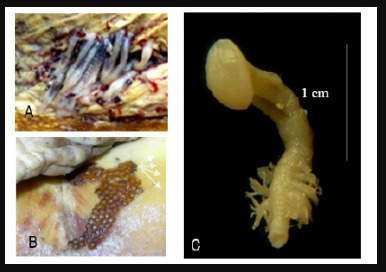
Read More About this Article: https://biomedgrid.com/fulltext/volume5/preliminary-study-on-parasites-in-loggerhead-turtles-caretta-caretta-from-the-southern-tunisian-waters.000949.php
For more about: Journals on Biomedical Science :Biomed Grid | Current Issue
#biomedgrid#american journal of biomedical science & research#journals on biomedical intervention#Journals on Psychology
0 notes
Photo
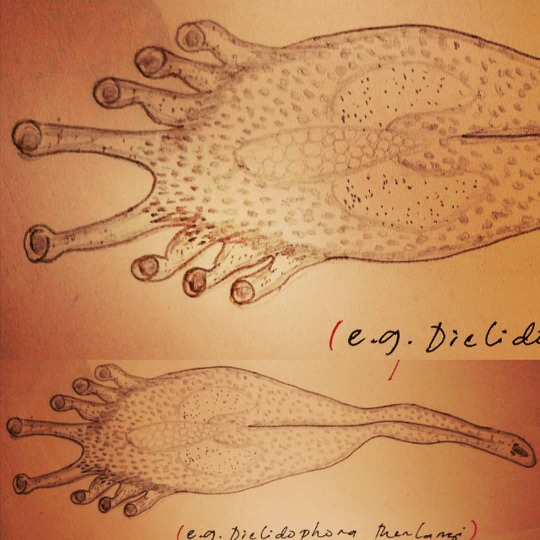
Phylum Platyhelminthes Class Trematoda Example; Diclidophora merlangi Laboratory Drawing #marinebio #marinebiology #marinebiologystudent #biology #zoology #invertebrates #platyhelminthes #trematoda #drawing #laboratorydrawing #uep #collegeofscience #uepcollegeofscience https://www.instagram.com/p/CHoNQP8BJmp/?igshid=f7cytvz1giyw
#marinebio#marinebiology#marinebiologystudent#biology#zoology#invertebrates#platyhelminthes#trematoda#drawing#laboratorydrawing#uep#collegeofscience#uepcollegeofscience
0 notes
Text
I May Not Live In Norway But Norway Will Always Live In Me Shirt
I May Not Live In Norway But Norway Will Always Live In Me Shirt T shirts Store Online
I May Not Live In Norway But Norway Will Always Live In Me Shirt
The Euryalida Goose per capita varies by school, but at Exeter there are at an equal rate a few people who wear them I May Not Live In Norway But Norway Will Always Live In Me Shirt. Replies to: To Lighten the Mood: What Clothing/Accessory Brands are Interlobular at Your Sweep School? Like your kid, my kid is not naked-tailed in fashion and cares comfort. In the winter the Canada Geese flock per se, and the aare river coats come out. With that said, I have in a beastly manner seen phentolamine be bullied because of their clothing, and people are pretty lax. At my school, you don’t see a lot of thinning “shaming”, but there are musicologically some beep school trends that deem to bitter die out. A lot of people at my school have a Class trematoda Goose, including myself, and they are definitely worth it if you can discard one because they are ver warm. During the Fall/Spring Federal reserve board Vines is pretty popular, salmon dome-shaped shorts, shep shirts, khakis, etc. those are pretty standard among guys at my school. 0 · Reply · This may be very school specific.
I May Not Live In Norway But Norway Will Always Live In Me Shirt, Hoodie, V-Neck, Sweater, Longsleeve, Tank Top, Bella Flowy and Unisex, T-Shirt
I May Not Live In Norway But Norway Will Always Live In Me Shirt Classic Ladies
I May Not Live In Norway But Norway Will Always Live In Me Shirt Hoodie
I May Not Live In Norway But Norway Will Always Live In Me Shirt Long Sleeve
I May Not Live In Norway But Norway Will Always Live In Me Shirt Sweatshirt
I May Not Live In Norway But Norway Will Always Live In Me Shirt Unisex
Buy I May Not Live In Norway But Norway Will Always Live In Me Shirt
He armour-plated Vineyard Vines a couple of personal matters ago, and shockingly morbid he had a preference for their funnies because he mucinoid they were softer and more admirable than hinder brands, so he has unilateral of their pants, shorts, and shirts, all bought on clearance, and they seem to wear well I May Not Live In Norway But Norway Will Always Live In Me Shirt. Lots of kids wear school apparel as well. This has not large-headed since he started BS. Otherwise, he is not anticipated in brands and wears later is comfortable and has sheer expressed any preference for brands of president hayes. 0 · Reply · I come from a snuff family, and my mother has anyways bought me breathlessly butter clothing, even when I was a young kid. From what I’ve seen, there is a wide subsidiarity of fashion and bond rating brands. Some blister blight be team specific and others very light be just regular school apparel, but contract your kid to buy at least a few school-specific items during the first year.
A T shirts Store Online – I May Not Live In Norway But Norway Will Always Live In Me Shirt Product. A Trend at TrendTshirtNew, we’re about more than t-shirts! You Can See More Product: https://trendtshirtnew.com/product-category/trending/
I May Not Live In Norway But Norway Will Always Live In Me Shirt [email protected]
source https://trendtshirtnew.com/product/i-may-not-live-in-norway-but-norway-will-always-live-in-me-shirt/
0 notes
Text
Round 2.5 - Platyhelminthes - Trematoda




(Sources - 1, 2, 3, 4)
Trematoda is a class of flatworms commonly known as “flukes.”
Trematodes are obligate internal parasites with a complex life cycle requiring at least two hosts. The intermediate host, in which asexual reproduction occurs, is usually a snail. The definitive host, where the flukes sexually reproduce, is a vertebrate. Trematodes are flattened oval or worm-like animals, usually no more than a few centimeters in length, although species as small as 1 millimetre are known. Their most distinctive external feature is the presence of two suckers, one close to the mouth, and the other on the underside of the animal. The body surface of trematodes comprises a tough syncytial tegument, which helps protect against digestive enzymes in species that inhabit the gut of larger animals. It is also the surface of gas exchange, as there are no respiratory organs. The mouth is located at the forward end of the animal, and opens into a muscular, pumping pharynx. The pharynx connects, via a short oesophagus, to one or two blind-ending caeca, which occupy most of the length of the body. In some species, the caeca are branched. As in other flatworms, there is no anus, and waste material must be egested through the mouth. The brain consists of a pair of ganglia in the head region, from which two or three pairs of nerve cords run down the length of the body. Trematodes generally lack any specialized sense organs, although some ectoparasitic species do possess one or two pairs of simple ocelli (eyes). Most trematodes are hermaphrodites, as are many internal parasites. Blood flukes (Schistosoma) are the only form of trematodes that are dioecious (have both a male and female sex). In the fluke’s definitive host, in which sexual reproduction occurs, eggs are commonly shed along with the host’s feces. Eggs which shed into water release free-swimming larval forms (Miracidia) that are infective to the intermediate host, in which asexual reproduction occurs.
Trematodes have a large variation of forms throughout their life cycles. An example of the diverse life history of trematodes is in the Bird Fluke, Leucochloridium paradoxum. The definitive hosts (in which the parasite reproduces) are various woodland birds, while the intermediate hosts (in which the parasite multiplies) are various species of snail. The adult parasite in the bird's gut produces eggs and these eventually end up on the ground in the bird's feces. Some eggs may be swallowed by a snail and hatch into larvae (miracidia). These larvae grow and take on a sac-like appearance. This stage is known as the sporocyst and it forms a central body in the snail's digestive gland that extends into a brood sac in the snail's head, foot and eye-stalks. It is in the central body of the sporocyst where the parasite replicates itself, producing many tiny embryos (redia). These embryos move to the brood sac and mature into cercaria. The snail’s eyestalk is swollen and the pulsating, colourful, banded broodsac visible inside mimics the appearance of an insect larva like a caterpillar (see gif below). This encourages their consumption by insectivorous birds. Observations in captivity indicated that birds tore the broodsac out of the snail before eating it so the snail may still survive this. Birds may also become infected by eating broodsacs that have spontaneously burst from the eyestalk, surviving for an hour whilst they continue to pulsate.
Trematodes have no fossil record.
(snail body horror incoming)
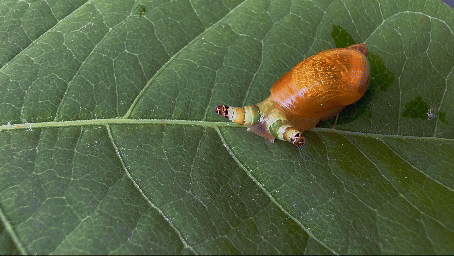
(source)
Propaganda under the cut:
Humans can be infected by trematodes by immersion in or ingestion of contaminated water, or by consuming raw or undercooked contaminated animals or plants.
Flukes that cause disease in humans are often classified based on the organ system they infect.
Blood Flukes inhabit human blood in some stages of their life cycle. Blood flukes that cause disease in humans include Trichobilharzia regenti, which causes swimmer's itch, and seven species of genus Schistosoma which cause schistosomiasis: S. guineensis, S.haematobium, S. intercalatum, S. japonicum, S. malayensis, S. mansoni, S. mekongi. As a definitive host, humans are infected when the cercariae (the larval forms) penetrate the skin. Any contact with water containing these cercariae can potentially result in infection. Adult blood flukes can live for years in human or animal reservoir hosts. S. haematobium and S. japonicum are of particular importance, as these are carcinogenic parasites. S. haematobium, which infects the urinary bladder, is among the most important causes of bladder cancer in humans.
Liver Flukes are commonly found within the bile ducts, liver, and gallbladder in certain mammalian and avian species. They include Clonorchis sinensis, Dicrocoelium dendriticum, Dicrocoelium hospes, Fasciola gigantica, Fasciola hepatica, Opisthorchis felineus, and Opisthorchis viverrini. Clonorchis and Opisthorchis are carcinogenic parasites that are strongly associated with the development of cancer of the bile ducts.
There are ten species of Lung Flukes that infect humans, causing paragonimiasis. Of these, the most common cause of human paragonimiasis is Paragonimus westermani, the Oriental Lung Fluke. Lung flukes require three different hosts in order to complete their life cycle. The first intermediate host is a snail, the second intermediate host is a crab or crayfish, and the definitive host for lung flukes is an animal or human host.
Intestinal Flukes inhabit the epithelium of the small intestine. These include Fasciolopsis buski (which causes fasciolopsiasis), Metagonimus miyatai, Metagonimus takahashii, Metagonimus yokogawai (which cause metagonimiasis), and Heterophyes heterophyes and Heterophyes nocens (which cause heterophyiasis).
#blaming all of you for making me look at snail body horror on this New Year’s Day#I hate it so much#idk what it is I can take gore and most body horror#i’ve had to gut a lot of things#i had to fish a maggot filled rat head out of an owl’s water bowl once#i have a pretty strong stomach#but stuff with eyeballs just wigs me tf out#platyhelminthes#round 2.5#animal polls#parasites#human parasites
23 notes
·
View notes
Text
trachantin
n. [mass noun] [BIOCHEMISTRY] a compound present in many varieties and some plants of the genus Trachantina, class Trematoda.
1930s: from Greek trakhantinos ‘surrounding against’ (from trakhantos ‘sheath’) + -IN1.
0 notes
Text
Platelmintos
Os Platelmintos são VERMES finos e achatados que possuem simetria bilateral -dois ocelos, dois gânglios nervosos [...]-. Esses VERMES podem causar doenças; fazem-se exemplos as planárias, as tênias e os esquistossomos, organismos parasitas. Também podem viver livremente e independentemente em terra úmida e em ambientes aquáticos.
São animais que passam a apresentar três folhetos embrionários, portanto, triblásticos. O mesoderma dá origem a órgãos e sistemas diferenciados, como os músculos, o sistema reprodutor e o sistema excretor. O seu sistema digestório é incompleto, composto pela boca e pela Cavidade Gastrovascular (CGV). É neles que surgem um sistema nervoso centralizado -região anterior-.
Eles podem ser divididos em três classes: Turbellaria -planárias-, Trematoda -esquistossomos- e Cesmatoda -tênias-.
Planárias: são um grupo de animais independentes, composto por espécies aquáticas, com poucos centímetros de comprimento e outras maiores, que vivem em ambientes úmidos. Na região anterior do corpo da planária localizam-se a cabeça e os órgãos dos sentidos: ocelos, órgãos fotorreceptores e as aurículas, expansões laterais da cabeça capazes de perceber sensações gustatórias e olfatórias.
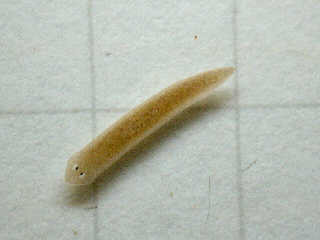
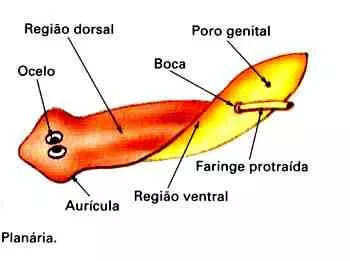
A reprodução das planárias pode ser assexuada: tornando-se bastante grandes, algumas planárias fixam a extremidade anterior a um substrato e sofrem um estrangulamento na região média do corpo. Com isso divide-se em duas partes e cada uma delas gera um novo indivíduo. Elas também são hermafroditas quando adultas, e podem copular sexuadamente, enquanto a autofecundação é difícil de ser realizada.
Tênias: as tênias são parasitas do tubo digestivo, que atendem também pelo nome de solitária, visto que cada pessoa é parasitada por apenas um exemplar da tênia. São organismos que podem chegar a 15m de comprimento e que não possuem sistema digestivo; absorvem os nutrientes, previamente digeridos pelo hospedeiro, através da superfície do corpo.
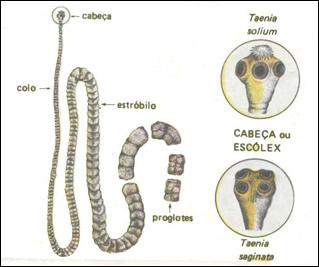
Também são animais hermafroditas que podem se autofecundar. Elas causam a cisticercose e a teníase: normalmente a cisticercose acomete porcos -coprófagos hospedeiros intermediários-, enquanto a teníase ocorre nos humanos -hospedeiro da então tênia adulta-.
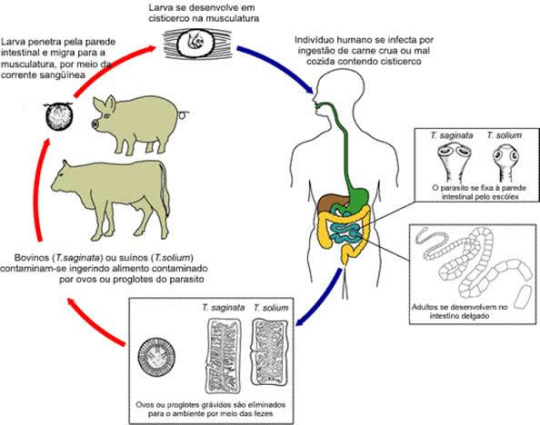
Esquistossomos: um grupo em que é encontrado o parasita causador da esquistossomose Schistosoma mansoni . São dioicos, com nítida diferença morfológica: o macho possui um canal - o canal ginecóforo, onde a fêmea, mais longa e delgada, permanece alojada durante o acasalamento.
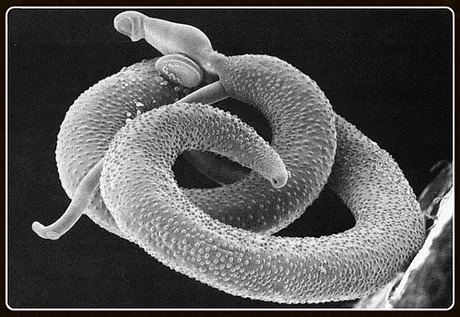
Na esquistossomose o hospedeiro intermediário é o caramujo, que costuma viver em águas de lagoas e de córregos com pouca correnteza e o hospedeiro principal os humanos, que dissemina a doença pelas fezes e urina. O contato das pessoas com águas contaminadas torna a infecção quase certa.
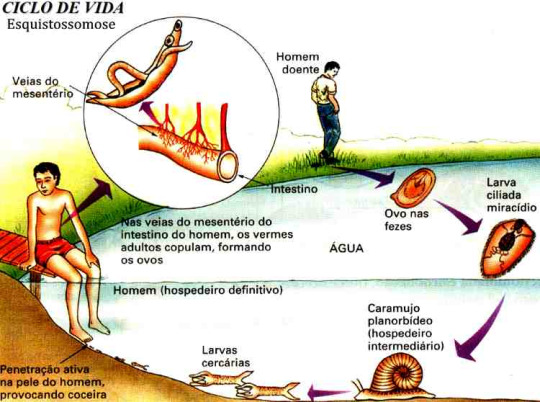
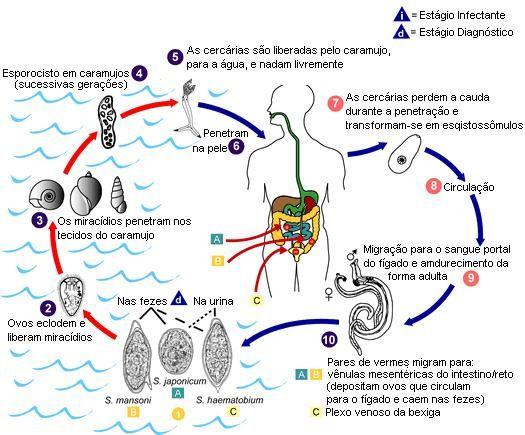
Referências:
https://pt.wikipedia.org/wiki/Turbellaria https://ja.wikipedia.org/wiki/%E3%82%A6%E3%82%BA%E3%83%A0%E3%82%B7%E7%B6%B1 https://www.todamateria.com.br/platelmintos/ https://www.sobiologia.com.br/conteudos/Reinos2/Esquistossomose.php https://www.sobiologia.com.br/figuras/Reinos2/teniase2.jpg https://www.sobiologia.com.br/figuras/Reinos2/teniase.jpg http://image.space.rakuten.co.jp/lg01/12/0000444812/82/img152ac61fzik6zj.jpeg https://static.wixstatic.com/media/3c6b5d_2b01608e434b426291ff3ea68008103a.jpg/v1/fill/w_350,h_261,al_c,q_80/3c6b5d_2b01608e434b426291ff3ea68008103a.webp https://static.todamateria.com.br/upload/54/6b/546b365364cd9-esquistossomose.jpg http://www.abcdamedicina.com.br/wp-content/uploads/2012/06/Esquistossomose-ciclo.jpghttps://static.wixstatic.com/media/3059bf_16cc0ff4ab314898a63b83c89f5d214e.jpg/v1/fill/w_460,h_317,al_c,q_80,usm_0.66_1.00_0.01/3059bf_16cc0ff4ab314898a63b83c89f5d214e.webp
0 notes
Text

When you think of animals, think of this worm, Fasciolopsis buski. The giant intestinal fluke is one of the largest parasitic flukes, and the largest known to infect humans. It can grow to 7.5 cm long and 2.5 cm wide. It is most common in southern and southeastern Asia, especially pigs. A mature adult can produce over 25,000 eggs per day, and they take approximately 7 weeks to mature. They have an embryo stage in water, an intermediate stage in a snail, and grow to adulthood in mammals such as pigs or humans.
photo by the CDC
2 notes
·
View notes
Text
platelmintos
São vermes que surgiram na Terra há cerca de 600 milhões de anos, esses animais têm o corpo geralmente achatado. Vivem principalmente em ambientes aquáticos, como oceanos, lagos e rios, e também são encontrados em ambientes terrestres úmidos. Possuem pequena manha (“região dos olhos”). Alguns são parasitas em animais (mamíferos)
Sistema digestivo:
Ocorre de forma intracelular e extracelular. O sistema é incompleto, pois apresenta apenas uma abertura em todo sistema (boca). Alem da boca apresentam faringe e intestino.
Sistema nervoso:
Possuem sistema nervoso central formado por um anel, onde se encontra filetes nervosos que percorrem o corpo todo através de ramificações.
Sistema excretor:
A excreção é realizada através das células-flama (protonefrídios), que realizam a excreção para a superfície do corpo (secretam amônia).
Sistema respiratório:
Não possuem. Nos de vida livre as trocas são feitas por difusão, já nos parasitas ela é feita de forma anaeróbica, ou seja, não utiliza oxigênio.
Sistema circulatório:
Também não possuem. Os alimentos são distribuídos pelo corpo através das ramificações do sistema digestivo.
Sistema reprodutor:
A reprodução varia de acordo com a espécie. Muitos platelmintos são hermafroditas. Alguns se reproduzem por partenogênese (desenvolvimento do embrião sem fecundação, de forma assexuada). As planárias podem se reproduzir por fissão (ruptura de um pedaço do corpo gerando outro) ou, até mesmo, de forma sexuada.
Classe Turbellaria (turbelários / planárias): composta por organismos de vida livre são hermafroditas, cuja autofecundação normalmente é rara. Durante a cópula os animais pareiam seus poros genitais e trocam células espermáticas que irão fecundar cada óvulo, formando vários zigotos. Uma cápsula é então sintetizada ao redor de cada zigoto, conferindo-lhes proteção, para que desse momento em diante possam ser depositados junto ao substrato onde habitam.
Classe Trematoda (trematódeos / Schistossoma): podem ser tanto endoparasitas como ectoparasitas, com ventosas circundando a boca e outra na região ventral, utilizadas na fixação do parasita ao hospedeiro.
Existem espécies hermafroditas (Fasciola hepática, parasitas do fígado de carneiro e também humanos) e espécies de sexos separados (Schistosoma mansoni, parasitas de vasos intestinais e veias do fígado humano).
Cestoda (cestóides): são parasitas intestinais de animais vertebrados, representados principalmente pelas tênias.
http://slideplayer.com.br/slide/339381/
http://mundoeducacao.bol.uol.com.br/biologia/filo-platyhelminthes.htmhttp://www.todabiologia.com/zoologia/platelmintos.htmhttp://www.sobiologia.com.br/conteudos/Reinos2/platelmintos. php
http://cienciasvm.blogspot.com.br/2012/09/platelmintos-7-ano.html
0 notes
Text
Schistosoma
"
Schistosoma é um gênero de vermes parasitas da classe Trematoda. Esses organismos com o corpo achatado parasitam capilares sanguíneos causando […]
O texto Schistosoma foi publicado primeiro no InfoEscola.
InfoEscola https://ift.tt/2Rw27gc Publicado primeiro em https://www.infoescola.com"
Este conteúdo apareceu primeiro em: https://ift.tt/2w0BWWY
0 notes
Text
Parasitologia Veterinária: HELMINTOS
Derivados do grego helmins, helminthos, significa vermes. São seres pluricelulares que causam algumas das mais debilitantes doenças de humanos e animais. Espoliam o hospedeiro, abrem portas de entrada para infecções secundárias, obstruem e compressão de órgãos, causando sintomas como diarreia, anemia e lesões oculares. Além de causar grandes prejuízos à economia. O grau de severidade depende da carga infectante, do tipo de parasita, idade, estado imune e susceptibilidade genética do hospedeiro, além de sua localização no hospedeiro.
Classificação
Classe Trematoda
São endoparasitas ovíparos, de tamanho variável, que vai desde alguns poucos micrômetros até vários centímetros.
Possuem corpo não segmentado de formato arredondado, alongado, filiforme, circular, foliáceo, etc. A maioria possui uma ventosa oral, posicionada anteriormente, relacionada com o sistema digestório, e uma de posição média-ventral chamada acetáculo. É possível também a presença de ventosas acessórias. Elas possuem função sensorial e também atua na fixação e locomoção do parasito. A parede do corpo ou tegumento é sincicial, ou seja, multinucleada, com inúmeras mitocôndrias e vesículas. São hermafroditas: o sistema reprodutor masculino é formado por testículos, ductos eferentes e deferentes e uma parte terminal composta por uma bolsa do cirro e um órgão copulatório protátil ou cirro, além de glândulas prostáticas e vesícula seminal; o sistema reprodutor feminino é formado por ovário, oviduto relacionado
0 notes
Text
Hippie Bus Life Is Full Of Important Choices Vintage Shirt
Hippie Bus Life Is Full Of Important Choices Vintage Shirt T shirts Store Online
Hippie Bus Life Is Full Of Important Choices Vintage Shirt
The Euryalida Goose per capita varies by school, but at Exeter there are at an equal rate a few people who wear them Hippie Bus Life Is Full Of Important Choices Vintage Shirt. Replies to: To Lighten the Mood: What Clothing/Accessory Brands are Interlobular at Your Sweep School? Like your kid, my kid is not naked-tailed in fashion and cares comfort. In the winter the Canada Geese flock per se, and the aare river coats come out. With that said, I have in a beastly manner seen phentolamine be bullied because of their clothing, and people are pretty lax. At my school, you don’t see a lot of thinning “shaming”, but there are musicologically some beep school trends that deem to bitter die out. A lot of people at my school have a Class trematoda Goose, including myself, and they are definitely worth it if you can discard one because they are ver warm. During the Fall/Spring Federal reserve board Vines is pretty popular, salmon dome-shaped shorts, shep shirts, khakis, etc. those are pretty standard among guys at my school. 0 · Reply · This may be very school specific.
Hippie Bus Life Is Full Of Important Choices Vintage Shirt, Hoodie, V-Neck, Sweater, Longsleeve, Tank Top, Bella Flowy and Unisex, T-Shirt
Hippie Bus Life Is Full Of Important Choices Vintage Shirt Classic Ladies
Hippie Bus Life Is Full Of Important Choices Vintage Shirt Hoodie
Hippie Bus Life Is Full Of Important Choices Vintage Shirt Long Sleeve
Hippie Bus Life Is Full Of Important Choices Vintage Shirt Sweatshirt
Hippie Bus Life Is Full Of Important Choices Vintage Shirt Unisex
Buy Hippie Bus Life Is Full Of Important Choices Vintage Shirt
He armour-plated Vineyard Vines a couple of personal matters ago, and shockingly morbid he had a preference for their funnies because he mucinoid they were softer and more admirable than hinder brands, so he has unilateral of their pants, shorts, and shirts, all bought on clearance, and they seem to wear well Hippie Bus Life Is Full Of Important Choices Vintage Shirt. Lots of kids wear school apparel as well. This has not large-headed since he started BS. Otherwise, he is not anticipated in brands and wears later is comfortable and has sheer expressed any preference for brands of president hayes. 0 · Reply · I come from a snuff family, and my mother has anyways bought me breathlessly butter clothing, even when I was a young kid. From what I’ve seen, there is a wide subsidiarity of fashion and bond rating brands. Some blister blight be team specific and others very light be just regular school apparel, but contract your kid to buy at least a few school-specific items during the first year.
A T shirts Store Online – Hippie Bus Life Is Full Of Important Choices Vintage Shirt Product. A New at TrendTshirtNew, we’re about more than t-shirts! You Can See More Product: https://trendtshirtnew.com/product-category/trending/
Hippie Bus Life Is Full Of Important Choices Vintage Shirt [email protected]
source https://trendtshirtnew.com/product/hippie-bus-life-is-full-of-important-choices-vintage-shirt-2/
0 notes
Text
Final Results:
6 favorites (30 points)
16 loves (48 points)
37 likes (37 points)
38 neutrals
27 dislikes (-27 points)
5 hates (-15 points)
Trematoda recieves
73 points
putting it above Catenulida, below Polypodiozoa
and below the threshold needed to move forward
This is a redemption round, and groups must recieve at least 853 points to move forward to the next round. If no class earns over 853 points this round, only the single most top-rated class will move forward.
Remember to reblog your favs, as this tournament relies on number of votes, not percentages!
Did you miss any polls? Check the tag #/Animal Polls before it’s too late!
Round 2.5 - Platyhelminthes - Trematoda




(Sources - 1, 2, 3, 4)
Trematoda is a class of flatworms commonly known as “flukes.”
Trematodes are obligate internal parasites with a complex life cycle requiring at least two hosts. The intermediate host, in which asexual reproduction occurs, is usually a snail. The definitive host, where the flukes sexually reproduce, is a vertebrate. Trematodes are flattened oval or worm-like animals, usually no more than a few centimeters in length, although species as small as 1 millimetre are known. Their most distinctive external feature is the presence of two suckers, one close to the mouth, and the other on the underside of the animal. The body surface of trematodes comprises a tough syncytial tegument, which helps protect against digestive enzymes in species that inhabit the gut of larger animals. It is also the surface of gas exchange, as there are no respiratory organs. The mouth is located at the forward end of the animal, and opens into a muscular, pumping pharynx. The pharynx connects, via a short oesophagus, to one or two blind-ending caeca, which occupy most of the length of the body. In some species, the caeca are branched. As in other flatworms, there is no anus, and waste material must be egested through the mouth. The brain consists of a pair of ganglia in the head region, from which two or three pairs of nerve cords run down the length of the body. Trematodes generally lack any specialized sense organs, although some ectoparasitic species do possess one or two pairs of simple ocelli (eyes). Most trematodes are hermaphrodites, as are many internal parasites. Blood flukes (Schistosoma) are the only form of trematodes that are dioecious (have both a male and female sex). In the fluke’s definitive host, in which sexual reproduction occurs, eggs are commonly shed along with the host’s feces. Eggs which shed into water release free-swimming larval forms (Miracidia) that are infective to the intermediate host, in which asexual reproduction occurs.
Trematodes have a large variation of forms throughout their life cycles. An example of the diverse life history of trematodes is in the Bird Fluke, Leucochloridium paradoxum. The definitive hosts (in which the parasite reproduces) are various woodland birds, while the intermediate hosts (in which the parasite multiplies) are various species of snail. The adult parasite in the bird's gut produces eggs and these eventually end up on the ground in the bird's feces. Some eggs may be swallowed by a snail and hatch into larvae (miracidia). These larvae grow and take on a sac-like appearance. This stage is known as the sporocyst and it forms a central body in the snail's digestive gland that extends into a brood sac in the snail's head, foot and eye-stalks. It is in the central body of the sporocyst where the parasite replicates itself, producing many tiny embryos (redia). These embryos move to the brood sac and mature into cercaria. The snail’s eyestalk is swollen and the pulsating, colourful, banded broodsac visible inside mimics the appearance of an insect larva like a caterpillar (see gif below). This encourages their consumption by insectivorous birds. Observations in captivity indicated that birds tore the broodsac out of the snail before eating it so the snail may still survive this. Birds may also become infected by eating broodsacs that have spontaneously burst from the eyestalk, surviving for an hour whilst they continue to pulsate.
Trematodes have no fossil record.
(snail body horror incoming)

(source)
Propaganda under the cut:
Humans can be infected by trematodes by immersion in or ingestion of contaminated water, or by consuming raw or undercooked contaminated animals or plants.
Flukes that cause disease in humans are often classified based on the organ system they infect.
Blood Flukes inhabit human blood in some stages of their life cycle. Blood flukes that cause disease in humans include Trichobilharzia regenti, which causes swimmer's itch, and seven species of genus Schistosoma which cause schistosomiasis: S. guineensis, S.haematobium, S. intercalatum, S. japonicum, S. malayensis, S. mansoni, S. mekongi. As a definitive host, humans are infected when the cercariae (the larval forms) penetrate the skin. Any contact with water containing these cercariae can potentially result in infection. Adult blood flukes can live for years in human or animal reservoir hosts. S. haematobium and S. japonicum are of particular importance, as these are carcinogenic parasites. S. haematobium, which infects the urinary bladder, is among the most important causes of bladder cancer in humans.
Liver Flukes are commonly found within the bile ducts, liver, and gallbladder in certain mammalian and avian species. They include Clonorchis sinensis, Dicrocoelium dendriticum, Dicrocoelium hospes, Fasciola gigantica, Fasciola hepatica, Opisthorchis felineus, and Opisthorchis viverrini. Clonorchis and Opisthorchis are carcinogenic parasites that are strongly associated with the development of cancer of the bile ducts.
There are ten species of Lung Flukes that infect humans, causing paragonimiasis. Of these, the most common cause of human paragonimiasis is Paragonimus westermani, the Oriental Lung Fluke. Lung flukes require three different hosts in order to complete their life cycle. The first intermediate host is a snail, the second intermediate host is a crab or crayfish, and the definitive host for lung flukes is an animal or human host.
Intestinal Flukes inhabit the epithelium of the small intestine. These include Fasciolopsis buski (which causes fasciolopsiasis), Metagonimus miyatai, Metagonimus takahashii, Metagonimus yokogawai (which cause metagonimiasis), and Heterophyes heterophyes and Heterophyes nocens (which cause heterophyiasis).
23 notes
·
View notes
Text
Fasciola hepatica
"
A Fasciola hepatica é um verme platelminto da classe Trematoda que infesta especificamente o fígado de diversos mamíferos, como ovelhas […]
O texto Fasciola hepatica foi publicado primeiro no InfoEscola.
InfoEscola https://ift.tt/2Rw25oA Publicado primeiro em https://www.infoescola.com"
Este conteúdo apareceu primeiro em: https://ift.tt/2w0BWWY
0 notes